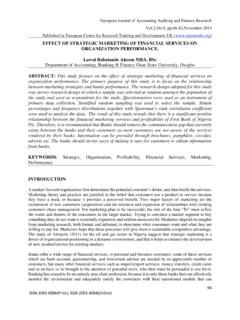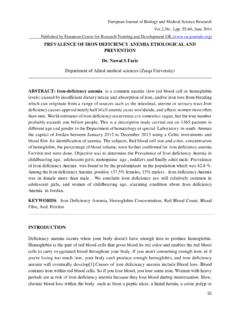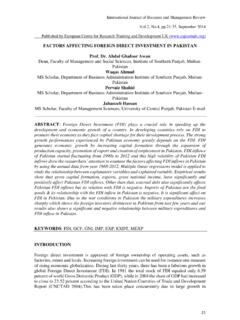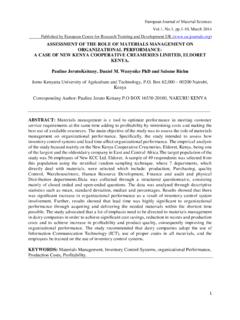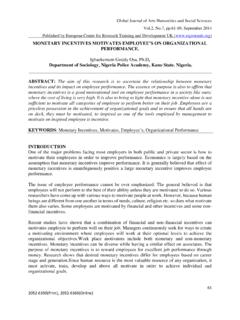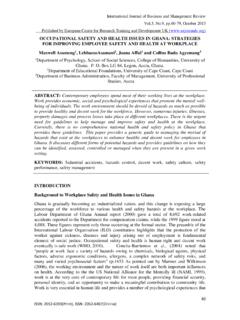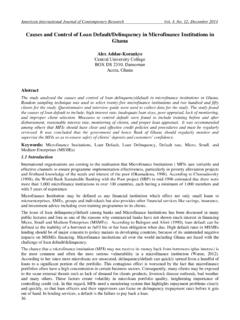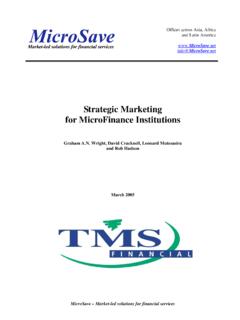Transcription of EFFECTS OF MICROFINANCE CREDIT ON THE PERFORMANCE …
1 International Journal of Small Business and Entrepreneurship Research , , , December 2015 ___Published by European Centre for Research Training and Development UK ( ) 57 ISSN 2053-5821(Print), ISSN 2053-583X(Online) EFFECTS OF MICROFINANCE CREDIT ON THE PERFORMANCE OF SMALL AND MEDIUM ENTEPRISES IN UASIN GISHU COUNTY, KENYA Kibet, K. Dennis, Kenneth Achesa and Dr. Omwono Gedion Student at the Catholic University of Eastern Africa, GABA campus, PhD scholar at Jomo Kenyatta University of Science and Technology, Town Campus Eldoret Kenya Lecturer at the Jomo Kenyatta University of Science and Technology, Town Campus Eldoret Kenya. ABSTRACT: This study discusses the EFFECTS of MICROFINANCE CREDIT on the PERFORMANCE of Small and Medium enterprises in Uasin Gishu County, Kenya. The study targeted over 5,000 entrepreneurs with a sample size of 47 SMEs.
2 The study employs an ex-post facto design. The instruments used in this study were open and closed ended Questionnaires, observation and interview guide. Face and content validity was used to ascertain the conceptual clarity and investigative bias. The study used simple random sampling of 47 SMEs out of the SMEs there were 17 SMEs did not take loan with MFIs while 30 SMEs have loans with MFIs. Data was presented through the use of frequency tables, pie charts and percentages. Data was analyzed using inferential statistics. In the final analysis, the research clearly found that MFC have a positive effect on the PERFORMANCE of SMEs with a level of significant of less than 5%. In order to enhance a sustained and accelerated growth in the operations of SMEs credits should be client-oriented and not product- oriented.
3 It s concluded that MFIs are concerned with provision of financial services to people who are economically poor and who therefore experience financial exclusion in that they do not have ready access to mainstream, commercial financial services. It is concerned with provision of financial services to poor people using means which are just, fair and sustainable for example they accept social collateral rather than financial collateral, access to larger amounts of loan if repayment is PERFORMANCE is positive, easy way to access finance in not much paper work, and easy and short procedures. KEYWORDS: MICROFINANCE CREDIT , PERFORMANCE and Small and Medium Enterprises INTRODUCTION Background to the Problem In recent years, both developed and developing countries support for SMEs development and growth has increased.
4 This is because of the contribution of SMEs to the employment creation. Evidence shows that a dynamic and growing SMEs sector can contribute to the achievement of a wide range of development objectives, including: the attainment of income distribution and poverty reduction (DFID, 2000); creation of employment (Daniels &Ngwira, 1993); savings mobilization (Beck et al., 2005); and production of goods and services that meet the basic needs of the poor (Cook &Nixson, 2000), Phillips &Kirchhoff (1989) cited by Pasanen (2006) found that young firms that grow have twice the probability of survival as young non-growing firms. It has been also found that strong growth may reduce the firm s profitability International Journal of Small Business and Entrepreneurship Research , , , December 2015 ___Published by European Centre for Research Training and Development UK ( ) 58 ISSN 2053-5821(Print), ISSN 2053-583X(Online) temporarily, but increase it in the long run (Pasanen, 2003).
5 The growth of SMEs is believed to be a desirable end as the key drivers of employment and economic development. Small and Micro enterprises are the backbone of many economies in Sub-Saharan Africa (SSA) and hold the key to possible revival of economic growth and the elimination of poverty on a sustainable basis. Despite the substantial role of the SMEs in SSA s economies, they are denied official support, particularly CREDIT , from institutionalized financial service organizations that provide funds to businesses. According to, these enterprises account more than one half of the economic activities of the countries within the sub- region, by contributing about 12% and 34% of rural and urban employment activities in Tanzania. Numerous evidences have pointed to the fact that the number of these enterprises in Tanzania is declining at an alarming rate and little has been achieved in Tanzania, despite of the many efforts done to fight for poverty reduction (Hamisi Madole, 2013).
6 The introduction of MFI s in Tanzania is seen as the best alternative source of financial services for low income earners and their SMEs as a means to raise their income, hence reducing their poverty level and contributing in country economy (Kessy&Urio, 2006). the service of MICROFINANCE institution to majority of Tanzanians who are low income earners have created opportunity to them including managing scarce household and enterprises resources more efficiently, protection against financial risks by taking advantages of investment opportunities and gaining economic returns (Chijoriga, 2000). Micro finance enables clients to protect, diversify and increase their incomes, as well as to accumulate assets, reducing their vulnerability to income and consumption shocks (Robinson, 2002).
7 Since Kenya attained independence in 1963, considerable efforts have been directed towards the nation s industrial development. The initial efforts were government-led through the vehicle of large industry, but lately emphasis has shifted to Small and Medium Enterprises (SMEs). The government encourages the MICROFINANCE crediting through licensing them and also giving them CREDIT by loaning them through the Central Bank of Kenya. In Uasin Gishu county micro finance CREDIT is not new in the sense that they used to loan each other through the popularly known chamas known in the region as merry go round. With the introduction of the MICROFINANCE institutions UG residents have exploited it hence effective business. Statement of the Problem Ideally, MICROFINANCE is a source of financial services for entrepreneurs and small businesses lacking access to banking and related services.
8 These include the provision of small loans to poor people, especially in rural areas, at full-cost interest rates, without collateral, that are repayable in frequent installments. Borrowers are organized into groups, which reduces the risk of default. These are also effective mechanisms through which to disseminate valuable information on ways to improve the health, legal rights, sanitation and other relevant concerns of the poor. Above all, many microcredit programmes have targeted one of the most vulnerable groups in society - women who live in households that own little or no assets. By providing opportunities for self-employment. Currently, most entrepreneurs have adopted the culture of getting capital from MFIs, than the commercial banks because of the ease in MFI CREDIT .
9 More so as top up they also continue with the tradition of saving and taking loans from groups (Chamas) within the contest of SHGs. International Journal of Small Business and Entrepreneurship Research , , , December 2015 ___Published by European Centre for Research Training and Development UK ( ) 59 ISSN 2053-5821(Print), ISSN 2053-583X(Online) Dellien et al. (2005) discusses key differences between the group lending and individual lending programs. First, because time and effort is invested in building social networks that enable groups to select members who are creditworthy under group lending, the role of loan officers is to provide structure, training on loan processes and administrative support. Under individual lending, loan officers bear principle responsibility for loan decisions; they screen, and monitor their clients as well as come up with mechanisms of enforcing repayment.
10 Second, the principle incentives for repayment of group loans is joint liability, group reputation, CREDIT rating and future access to CREDIT for each member, all of which are directly contingent on each member upholding their obligations. On the other hand, individual lending programs use a variety of incentives such as collateral requirements, co-signers and guarantors to promote repayment and repayment discipline is created by strict enforcement of contracts. Several studies have been done on this area, Waithanji, S .Wakaba,( 2014 )did a research on the effect of MICROFINANCE CREDIT on the financial PERFORMANCE of small and medium enterprises in kiambu county and found that all SMEs borrow investment capital and they use it for the purpose in which they borrowed for, most of them do not have other source of financing other than from micro-finance institutions and they did not have other form of financing before they started receiving financing from MICROFINANCE institutions .



